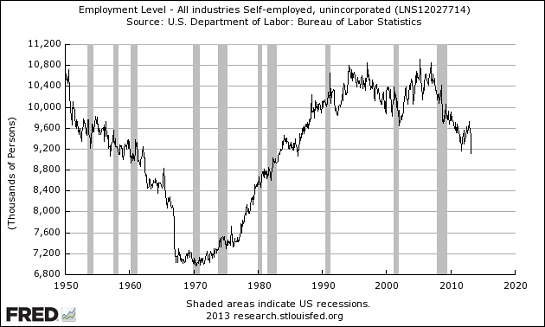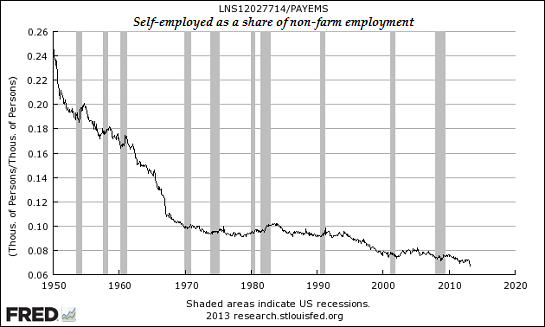“Small business is the incubator of employment. As it declines, so too do opportunities for first jobs, second chances and economic independence.
Self-employment and small business are two sides of a single economic coin: financial independence. The Bureau of Labor Statistics (BLS) counts two types of self-employed, the unincorporated and the incorporated. The unincorporated may have employees, but typically do not, i.e. they are sole proprietors. The incorporated have employees, starting with the owner, as the BLS counts the incorporated self-employed as employees of their own corporation.
I know that’s confusing, but it’s important to separate the sole proprietors from those “self-employed” incorporated businesses that have employees: law firms, doctors’ offices, accountants, etc.
When we speak of “small business,” we’re referring in large part to the incorporated self-employed: people who establish corporations as the legal structure for their enterprise.
Nothing is simple when it comes to parsing all the data, of course, but the BLS has a paper that explains the basic categories: Self-employment in the United States(Bureau of Labor Statistics).
The BLS attributes the decline in unincorporated self-employment from 1950 to 1970 to the consolidation of agriculture. As agriculture became more mechanized, small farms were no longer viable and farming required less labor. As a result, many self-employed farmers and laborers became employees or moved to other sectors.
The trajectory of self-employment from 1970 to the mid-2000s tracked general economic growth, which was weak in the 1970s but began a 30-year boom in the early 1980s. Things changed in the recession, as the self-employed ranks have lost 1.6 million from the peak in 2007. The number of self-employed has fallen to early 1980s levels: (All FRED charts courtesy of frequent contributor B.C.)

This chart displays the self-employed as a share of total non-farm employment. The first chart showed a strong rise in self-employment from 1970, but this chart shows that employment rose even faster: the self-employed share of all those employed has been declining for 30 years:

We can attribute this trend to the rise of global Corporate America and government employment. The workforce expanded, and relatively more people became employees of corporations or the government than became self-employed.
It’s important to note here that the BLS does not break down the income of unincorporated self-employed: if millions of self-employed saw their net incomes slashed in the recession, the BLS still counts them as self-employed. So a consultant who earned $100,000 prior to the recession and now scrambles to net $10,000 is still self-employed.
This is the statistical equivalent of 6 million people losing full-time jobs and then 4 million of those people getting part-time jobs. Did employment truly recover most of the losses?….”
If you enjoy the content at iBankCoin, please follow us on Twitter

